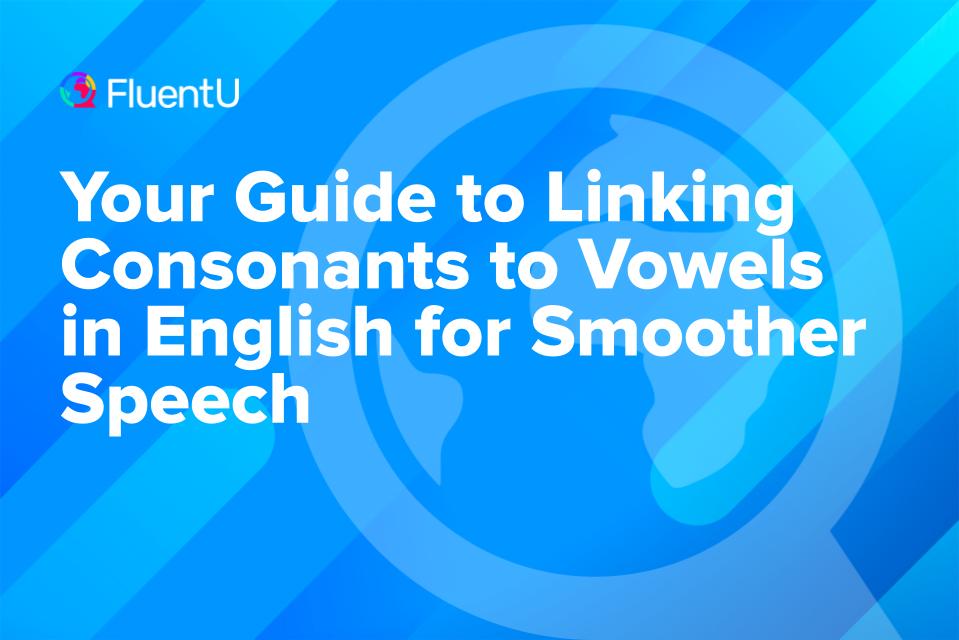Your Guide to Linking Consonants to Vowels in English for Smoother Speech

How can you tell apart a robot from a human?
Around 20 years ago, this question was easier to answer. When you talked to them, robots had a certain way of speaking: Hello. Human. I. Am. Happy. To. Assist. You.
There were sharp pauses between each word. It sounded unnatural, like you were playing a piano or violin and had to stop before every note instead of letting the music flow.
You might not have noticed it before, but in English, you don’t actually pause after every word. In fact, pauses can happen inside a word. While the difference can seem subtle, English speakers can hear it loud and clear. If you always pause between words, your English will sound choppy and more heavily accented.
Instead of pausing, you’ll have to do linking most of the time – letting one word flow smoothly into the other in certain cases. The most frequent type is linking consonants to vowels.
Read on to find out more about this important pronunciation feature of English. Once you apply this to how you speak, you’ll sound much closer to a native speaker.
Download: This blog post is available as a convenient and portable PDF that you can take anywhere. Click here to get a copy. (Download)
What is Consonant-Vowel Linking?
Linking is when there’s no gap in between words when you pronounce them. You can think of it as a marriage of words, where they connect and slide into each other. Here’s an example of linking:
- “Can I have some more ice?” → CanI have suhmorice?
The phrase “Can I” is pronounced as if it’s only one word (“CanI”). For “some more ice,” linking also happens, and it becomes “suhmorice” – technically three words on paper, but no pauses in between when said out loud.
Try it out for yourself slowly right now, and you’ll discover that it’s a lot more natural-sounding.
There are three types of linking:
- Consonant to consonant (“some more” → “suhmor”)
- Consonant to vowel (“shapes and colors” → “shapesand colors”)
- Vowel to vowel (“so open-minded” → “sowopen-minded”)
Linking Consonants to Vowels in English
Let’s be specific about what vowels and consonants are first:
- A vowel is a speech sound produced by the free flow of air through the mouth. For example, this includes sounds such as Aaaaah, Eiiii, Ohhhh. In written form, the letters ‘A,’ ‘E,’ ‘I,’ ‘O,’ and ‘U’ are vowels.
- A consonant is a speech sound that’s produced by stopping the airflow in some way. All other letters that aren’t vowels are considered consonants, such as ‘P,’ ‘K,’ ‘B,’ ‘D,’ and ‘T.’
Consonant-vowel linking happens when the first word you’re linking ends with a consonant and the next word starts with a vowel. The two words slide into each other.
Here’s a sample phrase: “travel again.”
Where would you put the pause? Without linking, you would pronounce it like this: “travel | again,” with the pause in between the two words.
However, the proper way to say this involves linking consonants to vowels.
Notice that the first word (“travel”) ends with a consonant, while the next word (“again”) starts with a vowel. A native English speaker would say: “tra | velagain.”
Aside from linking the two words, there’s also a slight pause before the linking – in fact, right in the middle of the first word. You can think of this as a beat inside words. We end up separating syllables inside a word to allow the C+V linking.
The easy rule is to put a small beat right before the final consonant sound of a linked word.
Check out these additional examples:
- “keep it” -> “keepit
- “apartment of” -> “apart | mentof”
- “jumping again” -> “jum | pingagain”
- “an orange” -> “anorange”
Consonant-Vowel Linking is All About Sound, Not Spelling
What about the following phrases – how would you pronounce them?
- “store is”
- “manage an”
- “bottle of”
You would also link consonants to vowels for all of these!
With linking, it’s not about the word’s spelling but rather about the sound. The word “store” might end with e, but say it out loud and the “e” practically disappears. It becomes “stor,” with a silent e. The sound it ends with is “r,” which is a consonant, so consonant-to-vowel linking will still apply.
It’s the same for “manage” and “bottle,” both of which end with a silent e:
- “store is” -> “storis”
- “manage an” -> “man | ijan”
- “bottle of” -> “bot | lof”
Practice Sentences for Linking Consonants to Vowels in English
Try saying these sample sentences out loud:
- In “Where are you?” we don’t pause between the first words. Instead we link → “Wher’ar you?”
- My name is John. → “My nay-miz John.”
- She’s a friend. → “She za friend.”
- She sent the email on Friday. → “She sent the e-mailon Friday.”
- I’m caught up with work. -> “I’m kaw–tup with work.”
- All of these files should be transferred. -> “Al’lof these files should be transferred.”
- How are you doing today? -> “How’ar you doing today?”
- He’s the person I’m looking for. -> “He’s the per sonI’m looking for.”
- These presentations are too time-consuming. -> “These presentation zar too time-consuming.”
- I’m reading this book about productivity. ->I’m reading this bookabout productivity.”
Tips for Linking Consonants to Vowels
1. Be aware that linking can trump punctuation
It’s possible for English words to be linked together even when they’re separated by a punctuation mark. Consonant-vowel linking can override:
- Commas → I saw it, and she did, too.
- Quotation marks → She said, “I don’t know.”
- Full stops → “I need this ASAP. A client is asking.”
Linking across full stops is hard to see in formal situations, but it happens in very fast, spontaneous speech – such as when you’re chatting excitedly with a friend.
2. Listen to how native English speakers pronounce words
Before you can speak English well, you also have to be able to listen well. For firsthand examples, listen to videos or recordings of native English speakers and notice when they link consonants to vowels. You can even slow down the audio so you can catch it.
It might even be helpful to listen to English songs – especially during the chorus when words are drawn out and emphasized. You can get started with these popular songs:
- “Let It Be” by The Beatles
- “Wonderwall” by Oasis
- “Rolling in the Deep” by Adele
Conclusion
Pronouncing each individual word correctly is an important part of speaking English, but it doesn’t stop there. English learners usually don’t notice linking unless it’s pointed out because the difference can sound very subtle. Linking isn’t as common in some other languages, either.
Although there are several kinds of linking, getting comfortable with linking consonants to vowels will instantly improve your English pronunciation. Just as notes are often connected together in music, linking allows you to speak in English smoothly and naturally. As much as linking makes English even quirkier, it’s a lot easier to pick up compared to grammar rules and silent letters!







